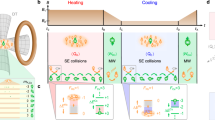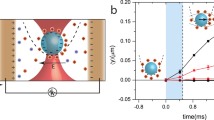Abstract
Performance of nano- and microscale heat engines can be improved with the help of quantum-mechanical phenomena. Recently, heat reservoirs with quantum coherence have been proposed to enhance engine performance beyond the Carnot limit even with a single reservoir. However, no physical realizations have been achieved so far. Here we report the first proof-of-principle experimental demonstration of a photonic quantum engine driven by superradiance employing a single heat reservoir composed of atoms and photonic vacuum. Reservoir atoms prepared in a quantum coherent superposition state underwent superradiance as they traversed the cavity. This led to about 40-fold increase in the effective engine temperature, resulting in near-unity engine efficiency. Moreover, the observed engine output power grew quadratically with respect to the atomic injection rate. Our work can be utilized in quantum-mechanical heat transfer as well as in boosting engine powers, opening a pathway to the development of photomechanical devices that run on quantum coherence embedded in heat baths.
This is a preview of subscription content, access via your institution
Access options
Access Nature and 54 other Nature Portfolio journals
Get Nature+, our best-value online-access subscription
$29.99 / 30 days
cancel any time
Subscribe to this journal
Receive 12 print issues and online access
$209.00 per year
only $17.42 per issue
Buy this article
- Purchase on Springer Link
- Instant access to full article PDF
Prices may be subject to local taxes which are calculated during checkout



Similar content being viewed by others
Data availability
Source data are provided with this paper.
Code availability
The code that supports the findings of this study are available from the corresponding author upon reasonable request.
References
Scovil, H. E. & Schulz-DuBois, E. O. Three-level masers as heat engines. Phys. Rev. Lett. 2, 262 (1959).
Allahverdyan, A. E., Johal, R. S. & Mahler, G. Work extremum principle: structure and function of quantum heat engines. Phys. Rev. E 77, 041118 (2008).
Zou, Y., Jiang, Y., Mei, Y., Guo, X. & Du, S. Quantum heat engine using electromagnetically induced transparency. Phys. Rev. Lett. 119, 050602 (2017).
Ma, Y.-H., Xu, D., Dong, H. & Sun, C.-P. Universal constraint for efficiency and power of a low-dissipation heat engine. Phys. Rev. E 98, 042112 (2018).
Klatzow, J. et al. Experimental demonstration of quantum effects in the operation of microscopic heat engines. Phys. Rev. Lett. 122, 110601 (2019).
Von Lindenfels, D. et al. Spin heat engine coupled to a harmonic-oscillator flywheel. Phys. Rev. Lett. 123, 080602 (2019).
Van Horne, N. et al. Single-atom energy-conversion device with a quantum load. npj Quantum Inf. 6, 37 (2020).
Bouton, Q. et al. A quantum heat engine driven by atomic collisions. Nat. Commun. 12, 2063 (2021).
Scully, M. O., Zubairy, M. S., Agarwal, G. S. & Walther, H. Extracting work from a single heat bath via vanishing quantum coherence. Science 299, 862–864 (2003).
Huang, X., Wang, T. & Yi, X. et al. Effects of reservoir squeezing on quantum systems and work extraction. Phys. Rev. E 86, 051105 (2012).
Roßnagel, J., Abah, O., Schmidt-Kaler, F., Singer, K. & Lutz, E. Nanoscale heat engine beyond the Carnot limit. Phys. Rev. Lett. 112, 030602 (2014).
Dağ, C. B., Niedenzu, W., Müstecaplıoğlu, Ö. E. & Kurizki, G. Multiatom quantum coherences in micromasers as fuel for thermal and nonthermal machines. Entropy 18, 244 (2016).
Klaers, J., Faelt, S., Imamoglu, A. & Togan, E. Squeezed thermal reservoirs as a resource for a nanomechanical engine beyond the Carnot limit. Phys. Rev. X 7, 031044 (2017).
Peterson, J. P. et al. Experimental characterization of a spin quantum heat engine. Phys. Rev. Lett. 123, 240601 (2019).
Scully, M. O., Chapin, K. R., Dorfman, K. E., Kim, M. B. & Svidzinsky, A. Quantum heat engine power can be increased by noise-induced coherence. Proc. Natl Acad. Sci. USA 108, 15097–15100 (2011).
Gelbwaser-Klimovsky, D., Niedenzu, W., Brumer, P. & Kurizki, G. Power enhancement of heat engines via correlated thermalization in a three-level ‘working fluid’. Sci. Rep. 5, 14413 (2015).
Wang, J., He, J. & Wu, Z. Efficiency at maximum power output of quantum heat engines under finite-time operation. Phys. Rev. E 85, 031145 (2012).
Hardal, A. Ü. & Müstecaplıoğlu, Ö. E. Superradiant quantum heat engine. Sci. Rep. 5, 12953 (2015).
Yamamoto, Y. & Imamoglu, A. Mesoscopic quantum optics. Mesoscopic Quantum Optics (1999).
Niedenzu, W., Gelbwaser-Klimovsky, D., Kofman, A. G. & Kurizki, G. On the operation of machines powered by quantum non-thermal baths. New J. Phys. 18, 083012 (2016).
Francica, G. et al. Quantum coherence and ergotropy. Phys. Rev. Lett. 125, 180603 (2020).
Friedberg, R. & Manassah, J. Dicke states and Bloch states. Laser Phys. Lett. 4, 900 (2007).
Le Kien, F., Scully, M. & Walther, H. Generation of a coherent state of the micromaser field. Found. Phys. 23, 177–184 (1993).
Kim, J., Yang, D., Oh, S.-H & An, K. Coherent single-atom superradiance. Science 359, 662–666 (2018).
Steck, D. A. Quantum and atom optics. (2007).
Türkpençe, D. & Román-Ancheyta, R. Tailoring the thermalization time of a cavity field using distinct atomic reservoirs. J. Opt. Soc. Am. B 36, 1252–1259 (2019).
Ma, Y.-H., Liu, C. & Sun, C. Works with quantum resource of coherence. Preprint at https://arxiv.org/abs/2110.04550 (2021).
Liu, S. & Ou, C. Maximum power output of quantum heat engine with energy bath. Entropy 18, 205 (2016).
Rodríguez-Rosario, C. A., Frauenheim, T. & Aspuru-Guzik, A. Thermodynamics of quantum coherence. Preprint at https://arxiv.org/abs/1308.1245 (2013).
Ronzani, A. et al. Tunable photonic heat transport in a quantum heat valve. Nat. Phys. 14, 991–995 (2018).
Lee, M. et al. Three-dimensional imaging of cavity vacuum with single atoms localized by a nanohole array. Nat. Commun. 5, 3441 (2014).
Yang, D. et al. Realization of superabsorption by time reversal of superradiance. Nat. Photon. 15, 272–276 (2021).
Quan, H.-T., Liu, Y.-X, Sun, C.-P. & Nori, F. Quantum thermodynamic cycles and quantum heat engines. Phys. Rev. E 76, 031105 (2007).
Acknowledgements
K.A. acknowledges financial support from the Korea Research Foundation (grant no. 2020R1A2C3009299) and the Ministry of Science and ICT of Korea under ITRC program (grand no. IITP-2021-2018-0-01402).
Author information
Authors and Affiliations
Contributions
Jinuk Kim and K.A. conceived the experiment. Jinuk Kim performed the experiment with help from S.O. and analysed the data and carried out the theoretical investigations. K.A. supervised the overall experimental and theoretical works. Jinuk Kim and K.A. wrote the manuscript. All the authors participated in the analyses and discussions.
Corresponding author
Ethics declarations
Competing interests
The authors declare no competing interests.
Peer review
Peer review information
Nature Photonics thanks Marlan Scully and the other, anonymous, reviewer(s) for their contribution to the peer review of this work.
Additional information
Publisher’s note Springer Nature remains neutral with regard to jurisdictional claims in published maps and institutional affiliations.
Extended data
Extended Data Fig. 1 The pressure-volume diagram.
The pressure-volume diagram of the superradiant quantum engine. The radiation pressure is represented by the photon number. The x axis is the cavity resonance frequency, which is inversely proportional to the cavity mode volume.
Supplementary information
Supplementary Information
Supplementary Figs. 1–5 and Notes 1–6.
Source data
Source Data Fig. 1
Statistical source data for Fig. 1
Source Data Fig. 2
Statistical source data for Fig. 2
Source Data Fig. 3
Statistical source data for Fig. 3
Rights and permissions
About this article
Cite this article
Kim, J., Oh, Sh., Yang, D. et al. A photonic quantum engine driven by superradiance. Nat. Photon. 16, 707–711 (2022). https://doi.org/10.1038/s41566-022-01039-2
Received:
Accepted:
Published:
Issue Date:
DOI: https://doi.org/10.1038/s41566-022-01039-2
This article is cited by
-
Frequency pushing enhanced by an exceptional point in an atom–cavity coupled system
Scientific Reports (2024)
-
Atom-level electronic physicists are needed to develop practical engines with a quantum advantage
npj Quantum Information (2023)
-
A quantum engine in the BEC–BCS crossover
Nature (2023)
-
Introduction to quantum thermodynamic cycles
Journal of Chemical Sciences (2023)
-
A supercharged photonic quantum heat engine
Nature Photonics (2022)



